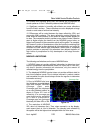
2-11
KMD 250 Pilot's Guide
Section 2
FIS Operation
Rev 4 Aug/2007
See the section on Understanding Textual Aviation Weather Reports, for
instructions on decoding textual AIRMETs.
SIGMET
A SIGMET (Significant Meteorological Information) is an advisory of non-
convective weather that is potentially hazardous to all aircraft. SIGMETs
address details regarding severe icing not associated with thunder-
storms, severe or extreme turbulence not associated with thunderstorms,
dust or sand storms lowering visibility to less than 3 miles, volcanic ash.
SIGMETs are considered widespread because they must either be
affecting or forecast to affect an area at least 3,000 square miles.
However, during the forecast period, the actual affected area may be
much smaller. SIGMETs are issued as needed and the maximum fore-
cast period is 4 hours, except for 6 hours for conditions associated with
hurricanes. A SIGMET will contain elements in the following order:
1. Forecast Area
2. Report Type
3. Date and time issued
4. Report designation and reason for issuance
5. Validity period
6. Area of coverage
7. Location of weather phenomenon
8. Weather phenomenon details.
These reports are displayed in an encoded textual format.
NOTE: SIGMETs older than the forecast period are discarded. Amended
or corrected SIGMETs generated within the issuance period are pro-
vided as soon as they are available, and the previous outdated SIGMET
is no longer transmitted.
When an SIGMET is cancelled, neither the original report nor the cance-
lation message can be displayed.
See the section on Understanding Textual Aviation Weather Reports, for
instructions on decoding textual SIGMETs.
CONVECTIVE SIGMET
A Convective SIGMET (Convective Significant Meteorological
Information) is an advisory of convective weather that the forecaster
believes hazardous to all aircraft. Convective SIGMETs address details
regarding severe thunderstorms, embedded thunderstorms, a line of
Basic Service Weather Products
KMD 250 FIS_R4 8/13/07 10:07 AM Page 2-11


















